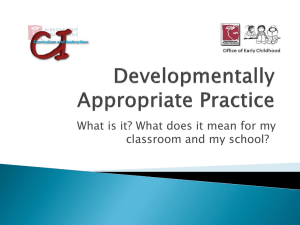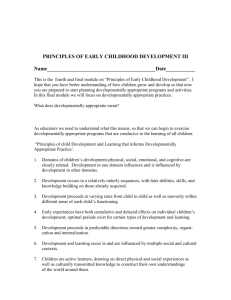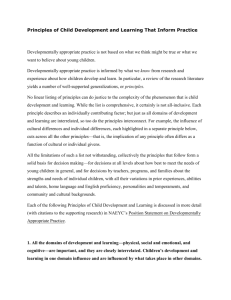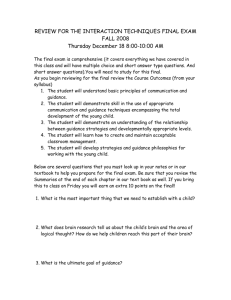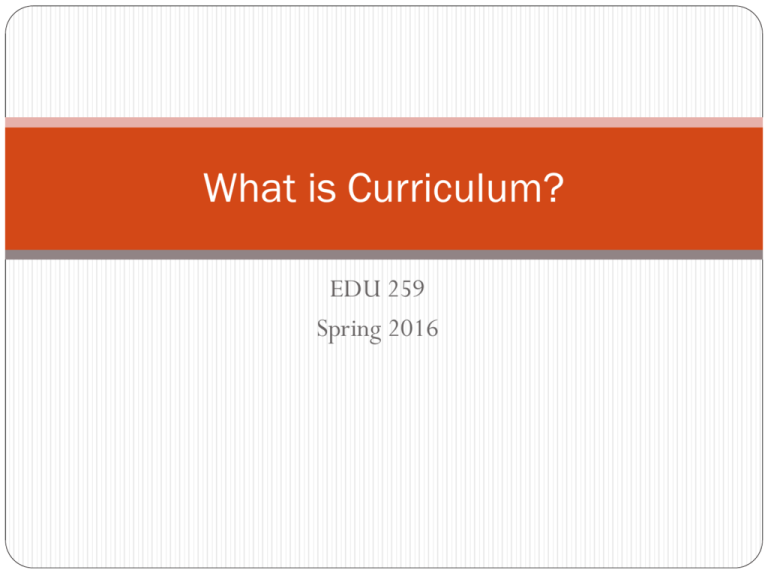
What is Curriculum?
EDU 259
Spring 2016
Curriculum for Young Children
Teaching is fun, exciting, and rewarding, especially
observing enthusiastic and happy children.
Copyright 2013 Wadsworth Cengage Learning.
All Rights Reserved.
What Is Curriculum?
1. Collection of ideas
including learning,
program, plans,
school subjects,
materials, topics of
study.
Looking at
Terminology
Particular words, or
terms, have
meaning and
significance.
2. Both planned and
unplanned
experiences to
develop skills and
knowledge.
Early childhood
programs do not
have fixed rules with
fixed terminology.
Copyright 2013 Wadsworth Cengage Learning.
All Rights Reserved.
Curriculum Defined
curriculum
a noun
A course of study; a program of studies (Barnhart and Barnhart, 1990)
Curriculum for young children is the topic of this textbook.
curriculums or curricula
plural
More than one course of study or program
The teacher tried many different types of curriculums. The teacher tried
many different types of curricula.
curricular
adjective
Of, having to do with, or describing curriculum
Early childhood educators continued to develop their curricular
practices.
Copyright 2013 Wadsworth Cengage Learning.
All Rights Reserved.
What Is Curriculum?
Curriculum is an organized framework that delineates:
•The content that children are to learn
•The process through which children are to learn
•The process through which children achieve the identified
curricular goals
•What teachers do to help children achieve these goals
•The context in which teaching and learning occur
Activities:
The Core of the Curriculum
1. Hands-on - children use their hands, arms,
legs, feet, and bodies rather than just listening
and observing teachers.
2. Concrete - allow children to use real
materials as active participants.
Copyright 2013 Wadsworth Cengage Learning.
All Rights Reserved.
Benefits of Planning and
Managing Your Curriculum
Ensures best
Gives sense of
opportunities to
predictability,
develop in secure,
confidence, and
stable, interesting
control.
environments.
Allows teachers to
predict and
prepare for events.
Maximizes use of time,
increases
opportunities for
quality interaction.
Copyright 2013 Wadsworth Cengage Learning.
All Rights Reserved.
Multilevel Process
Philosophy
- Expresses
basic principles, attitudes and beliefs of program
Goals
- General
overviews of what children are expected to gain
Objectives
- Specific teaching techniques or interpretations of the goals
- Meaningful descriptions of what is expected to be learned
- Designed to meet the physical, intellectual, cultural, social,
emotional, and creative development of each child
©2012 Cengage Learning.
All Rights Reserved.
DAP Curriculum
Goals are developmentally and educationally
significant
Learning experiences reflect what is known
- about young children in general
- about young children in particular
- about the sequences in which children acquire
specific concepts, skills and abilities
Builds on prior experience
©2012 Cengage Learning.
All Rights Reserved.
Developmentally Appropriate
Practice—What Is It?
Programs are based on the accumulation of data
and facts about what children are like
Programs designed for young children must be
based on what is known about young children
Early childhood educators must be steeped in child
development knowledge
Children must be considered in the context of
their family, culture, community, past history, and
present circumstances
© 2007 Thomson Delmar Learning. All Rights Reserved.
Basic Principles of Development
Domains of children’s development—physical,
social, emotional, and cognitive—are closely
related. Development in one domain influences and
is influenced by development in other domains
Development occurs in a relatively orderly
sequence, with later abilities, skills, and knowledge
building on those already acquired
Development proceeds at varying rates from child to
child as well as unevenly within different areas of a
child’s functioning
© 2007 Thomson Delmar Learning. All Rights Reserved.
Basic Principles of Development
Early experiences have both cumulative and delayed
effects on individual children’s development;
Optimal periods exist for certain types of
development and learning
Development proceeds in predictable directions
toward greater complexity, organization, and
internalization
Development and learning occur in and are
influenced by multiple social and cultural contexts
Basic Principles of Development
Children are active learners, drawing on direct
physical and social experience as well as culturally
transmitted knowledge to construct their own
under-standing of the world around them
Development and learning result from interaction
of biological maturation and the environment,
which includes both the physical and social worlds
that children
live in
Play is an important vehicle for children’s social,
emotional, and cognitive development, as well as a
reflection of their development
© 2007 Thomson Delmar Learning. All Rights Reserved.
Basic Principles of Development
Development advances when children have
opportunities to practice newly acquired skills as well
as when they experience a challenge just beyond the
level of their present mastery
Children demonstrate different modes of knowing
and learning and different ways of representing what
they know
Children develop and learn best in the context of a
community where they are safe and valued, their
physical needs are met, and they feel psychologically
secure
Common Misunderstandings about
Developmentally Appropriate Practice
There is only one right way to carry out
developmentally appropriate practice
Developmentally appropriate classrooms are
unstructured
Teachers teach minimally or
not at all in developmentally appropriate
classrooms
© 2007 Thomson Delmar Learning. All Rights Reserved.
Common Misunderstandings about
Developmentally Appropriate Practice
Developmentally appropriate programs do not include
academics, generally interpreted to be
the formal skills of learning reading, writing,
and arithmetic
Developmentally appropriate programs are only effective for
particular populations, “usually assumed to be typically
developing, white,
middle-class children”
In developmentally appropriate classrooms, there is no way to
tell whether children are learning
© 2007 Thomson Delmar Learning. All Rights Reserved.
Common Misunderstandings about
Developmentally Appropriate Practice
Developmentally appropriate practice can be
achieved simply by acquiring certain kinds of toys
and materials
Developmentally appropriate practice uses no goals
or objectives
In developmentally appropriate practice, the
curriculum is child development
Developmental appropriateness is just one in a
sequence of changing trends in education
© 2007 Thomson Delmar Learning. All Rights Reserved.
Inclusive Curriculum
Reflects awareness of and sensitivity to diversity of all areas
of a child’s life: cultural, social, language, religion, gender,
and capabilities
Authentic inclusion: an approach that builds on and
integrates multicultural and anti-bias strategies for a
sensitive and culturally affirming program that includes all
children
Children with disabilities, from immigrant families, from
families whose first language is not English, from all
cultures, and girls and boys need the same things in a
learning environment
Adaptations are made to fit the capacities of individual
children as needed
©2011 Cengage Learning.
All Rights Reserved.
Effective Curriculum:
Integrated Curriculum
Coordinates many subject areas and utilizes
a holistic approach to learning
Makes it possible for teachers to include
skill development activities in context, not
isolation
Subject areas cut across learning activities
and reinforce concepts in meaningful ways
as children engage in their work and play
©2011 Cengage Learning.
All Rights Reserved.
Effective Curriculum:
Advantages of an Integrated Curriculum
Reflects the natural way children develop at their
own rate and not in all areas of growth at the same
time
Allows for a wide range of abilities within a
classroom age range of one year, as well as within a
mixed-age group
Accommodates individualization as children meet a
variety of materials and experiences at their own
unique developmental levels
Maximizes the effect of rates of learning, different
styles of learning, and multiple intelligences
©2011 Cengage Learning.
All Rights Reserved.
Effective Curriculum:
Advantages of an Integrated Curriculum
Provides for learning to take place within the
context of meaningful activities
Requires large blocks of time so learning can be
more in-depth
Promotes self-motivation and extension of
learning
Blends hands-on learning with skill acquisition
Lends itself to both a theme and project approach
to curriculum planning
Effective Curriculum:
Emergent Curriculum
Curriculum that emerges out of the children’s
experiences and interests
Emphasis is on children’s interests, their
involvement in their learning, and their ability to
make constructive choices
Teachers set up materials and equipment for a
few activities each day that will capture children’s
interest, watch and evaluate what the children do,
and support and extend what the children make
of their experiences
©2011 Cengage Learning.
All Rights Reserved.
Effective Curriculum:
Emergent Curriculum (cont.)
Taking cues from children
Noting what they play with, what they avoid,
and what they change
In order to be a meaningful learning
experience, the curriculum should come out of
the daily life in the classroom
Children are encouraged to use whatever style
of learning is most natural to them
A materials-rich environment where play is
valued forms the foundation for the curriculum
©2011 Cengage Learning.
All Rights Reserved.
Effective Curriculum:
Emergent Curriculum (cont.)
Collaboration and mutual learning
Interaction between teachers and children, who
both offer suggestions and ideas
Accent is on mutual learning for both children
and adults
To be successful, teachers must listen and
observe carefully as children play and generate
new ideas, and then respond to what they hear
and see that the children have learned
©2011 Cengage Learning.
All Rights Reserved.
Effective Curriculum:
Emergent Curriculum (cont.)
Sources for Curriculum Ideas
Children
Teacher’s and parents’ interests and skills
Developmental tasks of the age group
The physical and natural environment, as well as people and things
Curriculum resource books
Family and cultural influences
Serendipity, or the unexpected
Daily issues of living together, problem solving, conflict
resolution, routines
Values expressed by the school philosophy, the families, and the
community
©2011 Cengage Learning.
All Rights Reserved.

